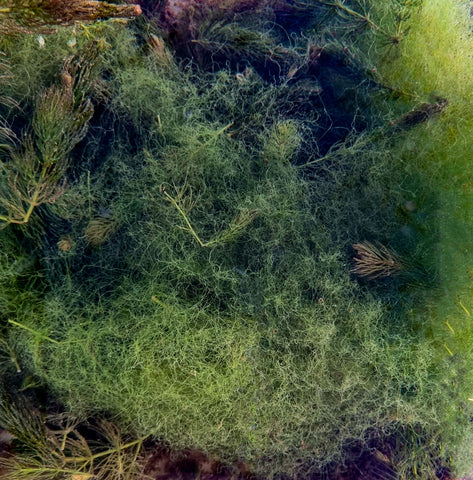Green Water, Algae & Blanket Weed Control
Green Water
We support our clients in achieving crystal-clear water in their ponds through proper filtration, maintenance, and the use of pond plants and treatments. This goal can be easily attained with our assistance. For additional details, please contact us today.

Algae and Blanket Weed
Excessive blooms of single-celled algae living in the water can cause green water, especially during warm and sunny spring days when light and excess nutrients are abundant. The type of algae present determines the various symptoms that may arise. The following are the most common symptoms of green water:
- The water may appear like a ‘pea soup’ due to the presence of fine algae suspended in it.
- A green scum that floats on the water's surface.
- Blanket weed or silk weed, which are hair-like green strands that cling to plants in the pond or float under or on the surface, are common types of pond algae.
- Nitrate, which is a nutrient that naturally forms from leftover fish food, fish waste, and dead plant material, can cause green water. Nitrate levels can be measured using our pond test kits. However, simply removing fallen leaves, cutting and discarding dead water-plant foliage, and avoiding overfeeding your fish can significantly reduce nitrate levels.
For further information, please contact us today.

If your pond is already experiencing issues with blanket weed and other floating algae, the following measures can be taken:
- Use a weed brush to twirl blanket weed and other floating algae out of the pond easily.
- To discourage pond algae, float a mesh bag of barley straw on the pond. The ideal amount of straw is about 50g per sq m of water surface area. The straw can be added in spring and removed after about six months when it has turned black. Lavender can be added to the barley straw for added effectiveness.
- For smaller ponds and water features, a liquid barley straw extract can be used. Several other products are also available that combine barley straw extract with a blend of micro-organisms designed to remove nutrients from the water and discourage algae growth.
- Various other treatments are available, but individual treatments only affect certain algae. Therefore, you may have to try several products to find the right one that works for your pond. Treatment needs to be repeated at intervals.
- It is not recommended to change the water in the pond as it will only provide a temporary solution and can result in increased algae growth afterward.
We have years of experience dealing with these issues and can assist with aquatic plant management, algae and blanket weed control.
